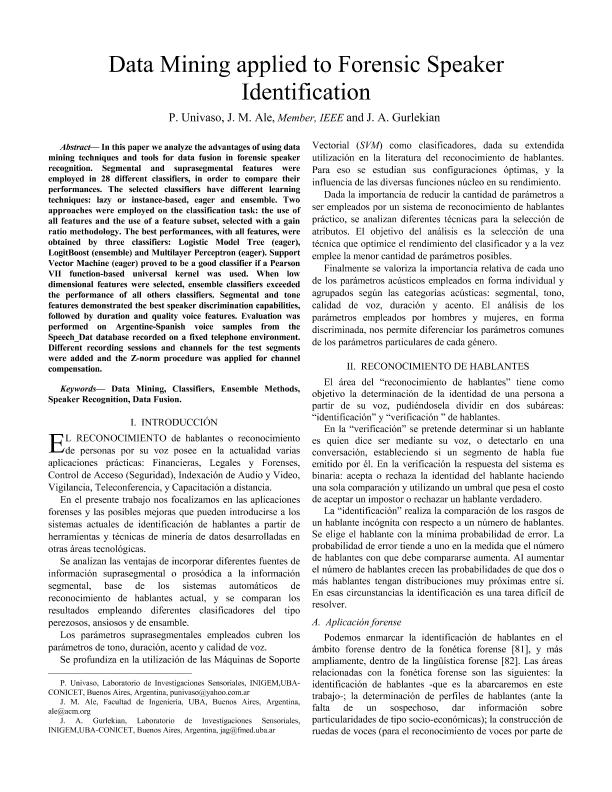Artículo
Data mining applied to forensic speaker identification
Fecha de publicación:
13/04/2015
Editorial:
Institute of Electrical and Electronics Engineers
Revista:
IEEE Latin America Transactions
ISSN:
1548-0992
Idioma:
Español
Tipo de recurso:
Artículo publicado
Clasificación temática:
Resumen
In this paper we analyze the advantages of using data mining techniques and tools for data fusion in forensic speaker recognition. Segmental and suprasegmental features were employed in 28 different classifiers, in order to compare their performances. The selected classifiers have different learning techniques: lazy or instance-based, eager and ensemble. Two approaches were employed on the classification task: the use of all features and the use of a feature subset, selected with a gain ratio methodology. The best performances, with all features, were obtained by three classifiers: Logistic Model Tree (eager), LogitBoost (ensemble) and Multilayer Perceptron (eager). Support Vector Machine (eager) proved to be a good classifier if a Pearson VII function-based universal kernel was used. When low dimensional features were selected, ensemble classifiers exceeded the performance of all others classifiers. Segmental and tone features demonstrated the best speaker discrimination capabilities, followed by duration and quality voice features. Evaluation was performed on Argentine-Spanish voice samples from the Speech_Dat database recorded on a fixed telephone environment. Different recording sessions and channels for the test segments were added and the Z-norm procedure was applied for channel compensation.
Palabras clave:
CLASSIFIERS
,
DATA FUSION
,
DATA MINING
,
ENSEMBLE METHODS
,
SPEAKER RECOGNITION
Archivos asociados
Licencia
Identificadores
Colecciones
Articulos(INIGEM)
Articulos de INSTITUTO DE INMUNOLOGIA, GENETICA Y METABOLISMO
Articulos de INSTITUTO DE INMUNOLOGIA, GENETICA Y METABOLISMO
Citación
Univaso, Pedro Nicolas; Ale, Juan Maria; Gurlekian, Jorge Alberto; Data mining applied to forensic speaker identification; Institute of Electrical and Electronics Engineers; IEEE Latin America Transactions; 13; 4; 13-4-2015; 1098-1111
Compartir
Altmétricas




